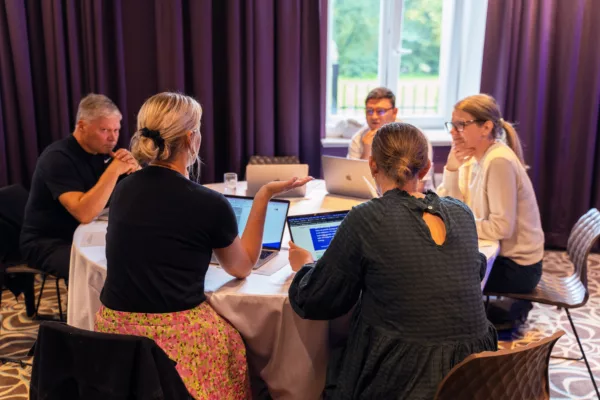
Three Cornerstones of Cultural Change in Organizations
As we all have no doubt experienced personally, humans are naturally resistant to change. While this trait often presents as frustrating, it actually serves an important purpose: psychological stability.
It is important for consistency that we don’t quickly unlearn what we have learned. But it also means that in order to create permanent change, time and effort are needed. Even with them, change cannot be forced upon a person externally. The person themselves have to be willing to change.
When it comes to cultural change, an organization behaves very similarly to humans in every way that matters – because it is composed of individuals. The internal mechanics of an organization are also rooted in its past experiences and occurrences, and it also tends to retain its defining features and only change very little over a very long period of time, if at all. Unless, of course, it embarks on a cultural change initiative.
Organizations resemble individuals also in how change is hard to make happen by external or top-down pressure. Instead, cultural change should be facilitated and co-created. This is an organic process and always unique to every organization, but it should always include these three cornerstones in order for it to be truly successful and long-lasting.
1. Invite the entire organization to take part in the change
There are a variety of different reasons why an organization would want to change its culture. For example, a company may have detected performance issues that originate from the current culture.
Many organizations embark on a change journey because the world has changed in some significant way and they want the organization to keep up with it – or they have changed themselves, for instance through a merger. Others realize after defining or redefining their mission and vision that a culture change is needed for the organization to be aligned with them.
Also, sometimes change takes place simply because the organization’s leadership has changed and the new people in charge have a different outlook or priorities.
Whatever the reason is for the need to change, it is important that this starting point is first communicated clearly to the entire personnel and that everyone is then invited to help shape the change journey.
This is far more effective than if the management created a roadmap amongst themselves and just presented it to the whole company later. Because culture is an integral part of the entire organization, the entire organization’s wisdom is needed to understand how it can and should change.
People have an innate need to be heard and understood. Co-creating organizational culture allows them the opportunity to share their insight and experience in a meaningful way. It is a process that benefits the individuals just as well as the organization.
2. Create a safe space for finding all the ‘whys’ for cultural change
As mentioned above, there usually is a trigger or a starting point as to why a cultural change initiative takes place in an organization. It’s the first ‘why’: Why do we need organizational culture change?
It is very important to acknowledge, however, that this ‘why’ is not enough. All the people that make up the organization must make sense of the process in their own way and find their own ‘whys’. The organization needs to learn the entire diversity of thoughts and feelings its people have on the change.
Here at Howspace, we call this sensemaking. The only way to create a sense of urgency is to help people understand on a personal level why a change is needed and in which direction that change will lead to in the future.
John Shotter talks about ‘withness’ thinking, meaning the feeling of being part of the organizational culture change as opposed to ‘aboutness’ thinking or looking at the culture from the outside. This is why it is crucial that the facilitator of the culture change invites the participants to co-create the transformation through the personal level and personal experiences.
The challenge, naturally, is that when a lot of people are involved, a lot of thoughts and ideas are produced. You are likely to need the help of technology to arrange this large volume of thoughts. Howspace, for instance, is powered by an AI that can analyze discussions, cluster them and produce word clouds or summaries.
As you facilitate this process, it is important that you also ensure that people feel they are safe to speak their mind honestly. Feelings are always involved when people are involved. One helpful idea is to allow anonymous commenting for particularly sensitive phases of the process.
3. Build cultural change on the organization’s strengths
As a person, if you only focus on your issues and how to fix them, it can paradoxically become more difficult to fix them. This is because such approach feeds negativity, which then in turn will both take up your energy and hamper your ability to envision what a successful change would look like.
Similarly, an organization does not ‘get well’ by merely producing a list of its issues and steps to fix them. People need inspiration and motivation. That’s why it’s important that the process focuses on discovering the strengths of the current culture.
Building change on strengths not only naturally facilitates desirable change but also helps the organization to crystallize its identity. Here at Howspace, for instance, we base much of our design on the work of David Cooperrider. According to him, discussion and dialogue should be given appropriate space and made inspiring, because that is how genuinely new thinking happens and also that is where an organization’s culture is defined.
What people study is what they will move towards. In a digital setting, this means we need to carefully formulate the questions we pose. Cooperrider suggests we either focus on what is currently working well or we focus on what could work well or create opportunities in the future.
Cultural change in an organization – remotely?
It is very likely that pandemic and its ripple effects will continue to drive organizations to remote working models for at least one or two more years, possibly longer. This, however, does not need to mean that your organization’s development needs to be put on pause! Even a complex, long-term process such as cultural change can be facilitated entirely remotely.
For example, Finnish bank, asset manager and life insurer Aktia was meant to organize a face-to-face day as the main event of its large culture change initiative in the spring of 2020. When the pandemic came, Aktia and development partner Milestone moved the event online at a very quick schedule – and felt, in the end, that in fact the digital environment had increased participation and equality.
Interested in learning more about effective implementation of organizational development in a digital environment? Download our free guide on the topic.
You might be interested in these as well
View all
Make Your Decision-Making More Inclusive and Effective
Participatory decision-making taps into the collective wisdom of your entire workforce. Here’s how to make more impactful decisions in your organization.

The best change management tools for successful organizational transformation
Embracing change within organizations can be challenging, as people naturally resist it. However, utilizing the right change management software can […]

Top 7 Virtual Organizational Transformation Strategies
When it comes to organizational transformation strategies and how to effectively lead change in a virtual environment, my pro tip […]